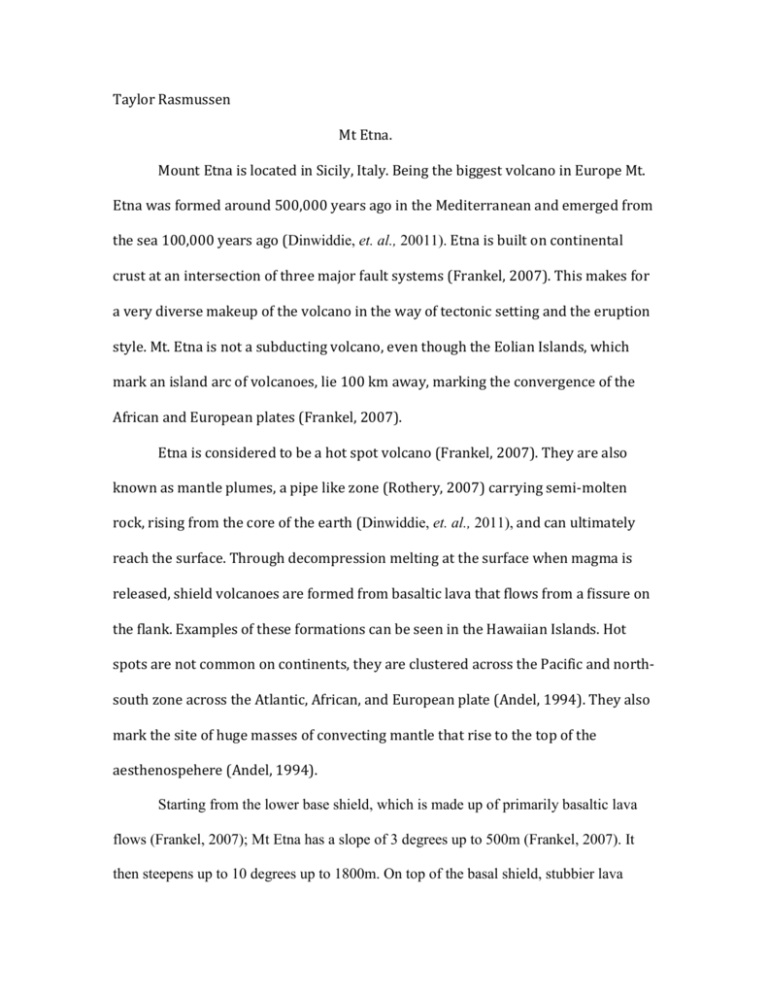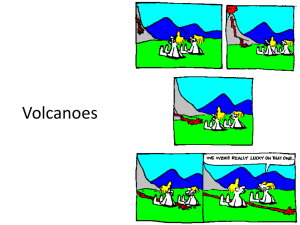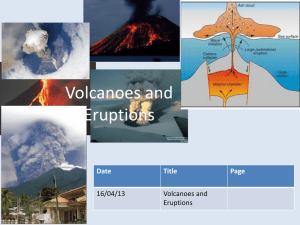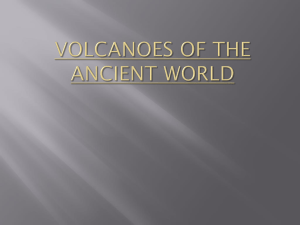File
advertisement

Taylor Rasmussen Mt Etna. Mount Etna is located in Sicily, Italy. Being the biggest volcano in Europe Mt. Etna was formed around 500,000 years ago in the Mediterranean and emerged from the sea 100,000 years ago (Dinwiddie, et. al., 20011). Etna is built on continental crust at an intersection of three major fault systems (Frankel, 2007). This makes for a very diverse makeup of the volcano in the way of tectonic setting and the eruption style. Mt. Etna is not a subducting volcano, even though the Eolian Islands, which mark an island arc of volcanoes, lie 100 km away, marking the convergence of the African and European plates (Frankel, 2007). Etna is considered to be a hot spot volcano (Frankel, 2007). They are also known as mantle plumes, a pipe like zone (Rothery, 2007) carrying semi-molten rock, rising from the core of the earth (Dinwiddie, et. al., 2011), and can ultimately reach the surface. Through decompression melting at the surface when magma is released, shield volcanoes are formed from basaltic lava that flows from a fissure on the flank. Examples of these formations can be seen in the Hawaiian Islands. Hot spots are not common on continents, they are clustered across the Pacific and northsouth zone across the Atlantic, African, and European plate (Andel, 1994). They also mark the site of huge masses of convecting mantle that rise to the top of the aesthenospehere (Andel, 1994). Starting from the lower base shield, which is made up of primarily basaltic lava flows (Frankel, 2007); Mt Etna has a slope of 3 degrees up to 500m (Frankel, 2007). It then steepens up to 10 degrees up to 1800m. On top of the basal shield, stubbier lava flows make for a steeper cone that is 20 degrees and rises to 2900m (Frankel, 2007). Having a steeper slope indicates that there are other types of eruption styles other than Hawaiian or fissure eruptions forming basaltic lava. There are four craters on the summit of Mt Etna. These produce amazing eruptions producing volcanic bombs, cinder showers and large ash clouds (Dinwiddie, et. al., .2011), also sometimes producing lava fountain or lava flows (Frankel, 2007). Making this volcano one of the most active and most studied volcanoes in the world (Frankel, 2007). Mt. Etna is classified at a Stratovolcano, built with steep sides and cone shape. It can have a variety of eruption styles ranging mild Hawaiian and Strombolian eruptions, then moving toward more violent Vulcanian, Peléan, or Plinian (Dinwiddie, et. al., 2011). This type of volcano can produce; cinders, ash clouds, lava bombs, pyroclastic flows, and lahars. Making for potentially dangerous for surrounding communities with the hot ash and mud rapidly approaching, if there was such a violent eruption. Hawaiian-style eruptions contain basaltic lava. When erupted lava flows rather than a pyroclastic eruption (Rothery, 2007). This is what is happening at the base of Mt. Etna causing the ground to gradually slope up in a shield formation; instead of having a steep base like you get at the top from Strombolian style eruptions, or other more violent eruptions. There are many parasitic cones that make their presence known and they can be seen from an aerial view Another eruption style that Mt. Etna displays is Strombolian. Cinder cones are the producers of this type of eruption throwing lava fragments into the air with short explosive burst (Dinwiddie, et. al., 2011). The cinder cone starts as small fissures and continue to grow and spit out lava bombs. Continuing to grow they can cause Strombolian and even Vulcanian type eruptions if conditions are right in magma and. The dangers of these eruptions are a little more dangerous than those of Hawaiian eruptions. There is relatively low lava flow from Strombolian style eruptions. Lava bombs that are thrust out can be hazardous from falling from the sky at fast speeds. These makes for build up of the steep slope of Etna littered with layers of lava and ash. Cinder cones form a crater in the volcano and lava flows out the side. These eruptions can last for a few minutes to days or weeks. Mt. Etna is capable of erupting violently and potentially killing many innocent people. With a Peléan eruption, caution should be taken. These emit a cloud of hot ash, rock and gas feeding the pyroclastic flow (Dinwiddie, et. al., 2011). There are cinder cones atop if Etna and there are capable of making pyroclastic flow. Potentially putting the townspeople at risk if it were to have this type of eruption. Mt Etna is very dynamic when it comes to the structure, of the volcano and eruption styles. It has erupted at least 190 times from 1226 B.C. to the present (Ritchie, Gates, 2007). This is an active volcano and it can erupt for days and even years depending on the circumstances of the magma chamber. In 122 B.C. on the S. flank, summit (cratere del Piano caldera) was a massive eruption. It erupted its central vent and also had radial fissures. It was an explosive, pryoclastic, caldera forming, empties is chamber and collapses on itself. It also caused some damage with the lava flow. This eruption had a VEI (Volcanic Explosivity Index) of 5 (Siebert, et. al., 2010), which can lead us to say that it was a Plinian eruption (Dinwiddie, et. al., 2007). In 1669 Etna had a very explosive eruption destroyed some of the summit and lava was flowing from a fissure on the south flank. It was central with radial fissures, explosive and had a lava flow. It flowed around 10 miles to the see and damaged to town of Catania (Gates, Ritchie, 2007). This happened over a four month time period (Siebert, et. al., 2010) 1776 was the year Etna had produced an estimated 4,000 million cubic ft threatening the town of Nicolosi on the southern flank (Dinwiddie, et. al., 2011). It was a central and explosive eruption with lava flow and did some damage as well. There was VEI of 2 making it a Strombolic eruption. (Siebert et. al., 2010) With Mt Etna having snow on it, this can make for a big disaster if the volcano erupts. In 1775, it did just that. Causing the ice and snow to melt, causing a lahar, it raced down flank carrying volcanic material and carving about a channel two miles wide and thirty four feet deep moving at a pace of around 40 miles per hour (Ritchie, Gates, 2007). More of these disasters have happened where 34 people were killed in 1834 due to a phreatic explosion. In 1852 a nine month eruption took over and produced over 2 billion cubic feet of lava flow over three square miles (Ritchie, Gates, 2007). Mt.Etna is a volcano that can sit quietly for years going about its cycle of eruptions, both Hawaiian and Strombolian. Sitting on the corner of the African plate that is near a subduction zone but Etna it self is not a subducting volcano, rather it’s a hot spot for mantle plumes to rise up from the core and potentially escape to the surface. This is a volcano that has many different elements that make it so unique. Four summit craters that erupt on their own possibly building enough pressure to have a Vulcanian eruption or maybe something more violent like a Peléan or Plinian. Theses are all a possible eruptions that could happen with Mt Etna; further research needs to happen to fully understand this Stratovolcano. Works Cited Dinwiddie, Robert, Simon Lamb, and Ross Reynolds. Violent Earth. London: DK, 2011. Print. Frankel, Charles. Worlds on Fire: Volcanoes on the Earth, the Moon, Mars, Venus, and Io. Cambridge, UK: Cambridge UP, 2005. Print. Ritchie, David, and Alexander E. Gates. Encyclopedia of Earthquakes and Volcanoes. New York: Facts on File, 2001. Print. Rothery, David A., and David A. Rothery. Volcanoes, Earthquakes, and Tsunamis. [Chicago]: McGraw-Hill, 2007. Print. Siebert, Lee, Tom Simkin, and Paul Kimberly. Volcanoes of the World. Third ed. Washington, D.C.: Smithsonian Institution, 2010. Print. Van, Andel Tjeerd H. New Views on an Old Planet: A History of Global Change. Second ed. Cambridge: Cambridge UP, 1994. Print. reprinted 1995








